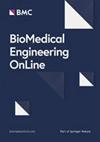用于预测卵巢肿瘤恶性风险的超声深度学习放射组学提名图的开发与验证
IF 2.9
4区 医学
Q3 ENGINEERING, BIOMEDICAL
引用次数: 0
摘要
及时发现和治疗卵巢癌是患者预后的关键因素。在这项研究中,我们开发并验证了基于超声(US)成像的深度学习放射组学提名图(DLR_Nomogram),以准确预测卵巢肿瘤的恶性风险,并将 DLR_Nomogram 的诊断性能与卵巢-附件报告和数据系统(O-RADS)的诊断性能进行了比较。这项研究包括两项研究任务。在两个任务中,患者按 8:2 的比例随机分为训练集和测试集。在任务 1 中,我们评估了 849 名卵巢肿瘤患者的恶性肿瘤风险。在任务 2 中,我们评估了 391 名 O-RADS 4 和 O-RADS 5 卵巢肿瘤患者的恶性风险。我们建立并验证了三个预测卵巢肿瘤恶性风险的模型。每个样本的模型预测结果被合并成一个新的特征集,该特征集被用作逻辑回归(LR)模型的输入,以构建一个组合模型,可视化为 DLR_Nomogram。然后,通过接收者操作特征曲线(ROC)对这些模型的诊断性能进行评估。任务 1 的训练集和测试集的 ROC 曲线下面积(AUC)值分别为 0.985 和 0.928,证明 DLR_Nomogram 在预测卵巢肿瘤恶性风险方面表现出卓越的预测性能。其测试集的 AUC 值低于 O-RADS,但差异无统计学意义。在任务 2 的训练集和测试集中,DLR_Nomogram 的 AUC 值最高,分别为 0.955 和 0.869。在 Hosmer-Lemeshow 测试中,DLR_Nomogram 在两个任务中都表现出令人满意的拟合性能。决策曲线分析表明,在特定的阈值范围内,DLR_Nomogram 在预测恶性卵巢肿瘤方面产生了更大的临床净效益。基于美国的 DLR_Nomogram 能够准确预测卵巢肿瘤的恶性风险,其预测效果与 O-RADS 不相上下。本文章由计算机程序翻译,如有差异,请以英文原文为准。
Development and validation of an ultrasound-based deep learning radiomics nomogram for predicting the malignant risk of ovarian tumours
The timely identification and management of ovarian cancer are critical determinants of patient prognosis. In this study, we developed and validated a deep learning radiomics nomogram (DLR_Nomogram) based on ultrasound (US) imaging to accurately predict the malignant risk of ovarian tumours and compared the diagnostic performance of the DLR_Nomogram to that of the ovarian-adnexal reporting and data system (O-RADS). This study encompasses two research tasks. Patients were randomly divided into training and testing sets in an 8:2 ratio for both tasks. In task 1, we assessed the malignancy risk of 849 patients with ovarian tumours. In task 2, we evaluated the malignancy risk of 391 patients with O-RADS 4 and O-RADS 5 ovarian neoplasms. Three models were developed and validated to predict the risk of malignancy in ovarian tumours. The predicted outcomes of the models for each sample were merged to form a new feature set that was utilised as an input for the logistic regression (LR) model for constructing a combined model, visualised as the DLR_Nomogram. Then, the diagnostic performance of these models was evaluated by the receiver operating characteristic curve (ROC). The DLR_Nomogram demonstrated superior predictive performance in predicting the malignant risk of ovarian tumours, as evidenced by area under the ROC curve (AUC) values of 0.985 and 0.928 for the training and testing sets of task 1, respectively. The AUC value of its testing set was lower than that of the O-RADS; however, the difference was not statistically significant. The DLR_Nomogram exhibited the highest AUC values of 0.955 and 0.869 in the training and testing sets of task 2, respectively. The DLR_Nomogram showed satisfactory fitting performance for both tasks in Hosmer–Lemeshow testing. Decision curve analysis demonstrated that the DLR_Nomogram yielded greater net clinical benefits for predicting malignant ovarian tumours within a specific range of threshold values. The US-based DLR_Nomogram has shown the capability to accurately predict the malignant risk of ovarian tumours, exhibiting a predictive efficacy comparable to that of O-RADS.
求助全文
通过发布文献求助,成功后即可免费获取论文全文。
去求助
来源期刊

BioMedical Engineering OnLine
工程技术-工程:生物医学
CiteScore
6.70
自引率
2.60%
发文量
79
审稿时长
1 months
期刊介绍:
BioMedical Engineering OnLine is an open access, peer-reviewed journal that is dedicated to publishing research in all areas of biomedical engineering.
BioMedical Engineering OnLine is aimed at readers and authors throughout the world, with an interest in using tools of the physical and data sciences and techniques in engineering to understand and solve problems in the biological and medical sciences. Topical areas include, but are not limited to:
Bioinformatics-
Bioinstrumentation-
Biomechanics-
Biomedical Devices & Instrumentation-
Biomedical Signal Processing-
Healthcare Information Systems-
Human Dynamics-
Neural Engineering-
Rehabilitation Engineering-
Biomaterials-
Biomedical Imaging & Image Processing-
BioMEMS and On-Chip Devices-
Bio-Micro/Nano Technologies-
Biomolecular Engineering-
Biosensors-
Cardiovascular Systems Engineering-
Cellular Engineering-
Clinical Engineering-
Computational Biology-
Drug Delivery Technologies-
Modeling Methodologies-
Nanomaterials and Nanotechnology in Biomedicine-
Respiratory Systems Engineering-
Robotics in Medicine-
Systems and Synthetic Biology-
Systems Biology-
Telemedicine/Smartphone Applications in Medicine-
Therapeutic Systems, Devices and Technologies-
Tissue Engineering
 求助内容:
求助内容: 应助结果提醒方式:
应助结果提醒方式:


